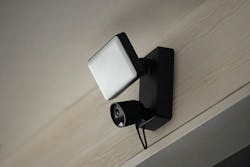Change is coming in Signify’s handling of Hue, its signature smart home lighting line for which sales have been struggling. Exactly what the next step will be is not clear. But CEO Eric Rondolat has signaled his intentions to act on the stark decline in a sector that the company pioneered.
“When you look at that business, it started really in 2012,” Rondolat said in response to an analyst’s question during a recent web call to discuss third-quarter results in which “connected consumer” products such as Hue plunged. “We had a fantastic ride, and especially in the years 2020, at the end of 2020 and 2021 was a fabulous year for that business.” He was referring to the stay-at-home boost of the COVID lockdown days, when consumer purchases surged.
“But we're entering another phase where we are also considering today many more competitors than what we had when we started,” Rondolat continued. “So we're looking at that business in very, very specific ways to see how we can give it a second breath. So that's the real point of attention today when it comes to market share.”
He did not state what measures are in store. The company is believed to be looking at new applications. Rondolat is hopeful, for example, that the recent introduction of a security feature in which Hue lights flash red when cameras detect an intruder will abet a turnaround.
Industry watchers believe that Signify’s comparatively high prices are impeding the business. As Rondolat noted, the market is full of vendors today that were not present a decade ago. Most of them sell at prices well below Signify’s.
Three months ago, Rondolat said that pricing is not really the issue.
“On the connected part of the market, we see some offers come at a lower price, but that’s not specifically circumstantially linked to the situation we see today,” he said at the time. “That has been happening for many, many years. When a market is attractive and developing, there are all sorts of actors coming. But there’s not specific massive downtrading there.”
He did not specifically address pricing in the third-quarter call.
Eindhoven, Holland–based Signify offers lower prices through its WiZ line of smart home products. But overall, the connected consumer business continues to slump, a trend that first emerged in August 2022, if not earlier.
The Signify boss was resolute that features such as the new security system will give Hue new and meaningful purpose. In Philips Hue Secure, Signify has built new features into the Hue app and is providing the cameras and motion sensors.
“When they sense motion, then we can activate light scenes,” Rondolat said. “At the same time, if a camera is sensing that there is an intrusion in the home, we can display some lighting alarm with all the lights flashing red. [...] I'm going to say it again, it's very interesting because a light flashing red, you see it from a very, very, very far distance, which is not the case for sound alarms. So this is basically where we are working very hard on that business to put it back on track and continue to grow share.”
By providing cameras and sensors, Signify is again showing its willingness to market non-lighting products in its efforts to chase IT-connected applications (also known as the IoT, or Internet of Things). In the professional market, its new Interact Space Analysis includes sensors and software that Signify markets both with or without lighting systems, to help facility managers improve their use of indoor space.
MARK HALPER is a contributing editor for LEDs Magazine, and an energy, technology, and business journalist ([email protected]).
Follow our LinkedIn page for our latest news updates, contributed articles, and commentary, and our Facebook page for events announcements and more. You can also find us on the X platform.







